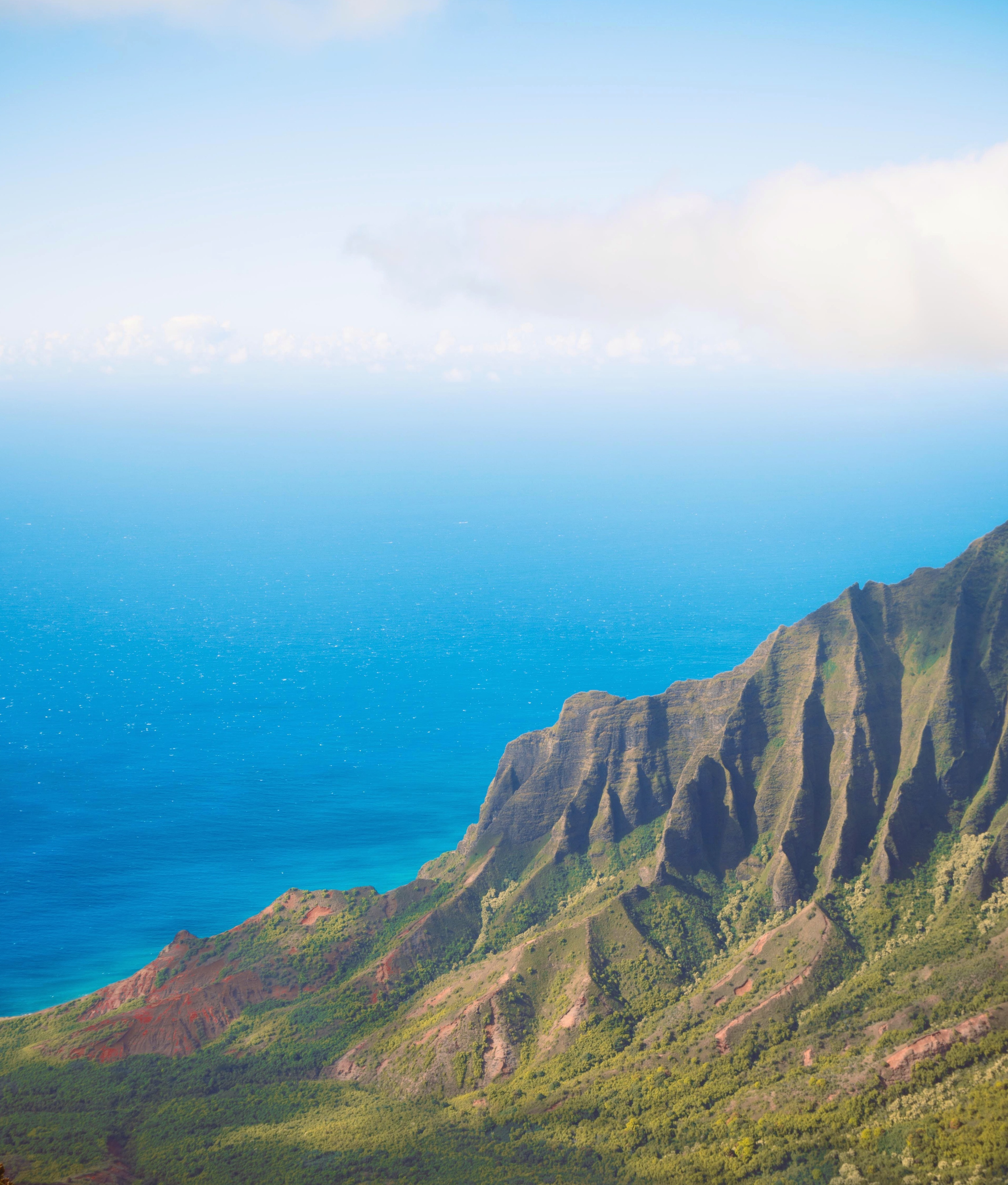
You don’t have to read much travel writing before you come across an inevitable comparison to Jurassic Park. 25 years since its release, we still invoke the film as the ultimate yardstick of the exotic and the otherworldly. I even have to cop to using it myself on occasion (to describe the Gathering of the Juggalos, of all things). If you’ve flown American lately there’s even an unavoidable Booking.com ad that plays on the in-flight entertainment system before every show. The ad features “actual footage shot by Booking.com employees on their travels.” It includes, as its centerpiece, an awe-struck Australian man canoeing through foresty wilderness uttering the ad’s only line: “…it’s lahke Jurassic Pahk out heah.”
I saw the ad at least six times on my flight to Kaua’i, which happens to be where Jurassic Park was filmed†. Kaua’i’s tourism board should probably get a nickel every time someone says “it’s like Jurassic Park,” because on some level, what we mean when we write it or say it is, “it’s like Kaua’i.” The image of Kaua’i has thus become unconscious shorthand for the exotic, the otherworldly, the fertile and fecund, the colossal in scale and the generally surreal: one of our most pervasive and least acknowledged cultural touchstones.
Even in ’93, Spielberg was only the latest in a long line of filmmakers to be inspired by Kaua’i’s landscape. King Kong, Lord of the Flies, South Pacific, and Fantasy Island all shot there before Jurassic Park, to name just a few. Since then Kaua’i’s wild spaces have doubled for the Philippine jungle in Tropic Thunder, the African savanna in Outbreak, and Kaua’i in The Descendants, one of the few films in which the scenery plays itself. Kaua’i’s defining feature as a setting, it seems, is that it can ground any fantasy.
One of the first things I noticed upon touching down on the island was all the chickens. They run wild over Kaua’i, in uncharacteristically colorful coats of red and burnt orange and black, sort of the plumage equivalent of aloha shirts. It’s one of the few places where you regularly see tourists trying to get that perfect snap of the lowly chicken — in this case, a genetically unique hybrid of domesticated and pre-European-contact feral species. Naturally, their image also graces the graphics on shirts, hats, mugs, and magnets in every souvenir and curio shop.
The wild chickens are a phenomenon, so the local story goes, exacerbated by hurricanes Iwa (1982) and Iniki (1993), the latter of which interrupted Jurassic Park‘s shooting schedule and forced the production over to O’ahu. The storms destroyed coops and fences, letting the birds escape, and, once freed, they continued to thrive because, unlike Hawaii’s other islands, Kaua’i has no mongeese. In that way, Kauai’s chickens are the inescapable mascot of “life finds a way.” Not as exciting as dinosaurs or giant gorillas maybe, but nonetheless emblematic of a place where the normal rules don’t apply. That’s Kaua’i, an anomaly even relative to the anomaly of greater Hawai’i, the most geographically isolated archipelago (furthest from any continent) on Earth, home to a greater percentage of endemic species.
Even on the map, Kaua’i looks like a straggler, set apart from the other major islands in the Hawaiian chain like the loner of the group, the northernmost island of the northernmost archipelago at the top of the Polynesian triangle.
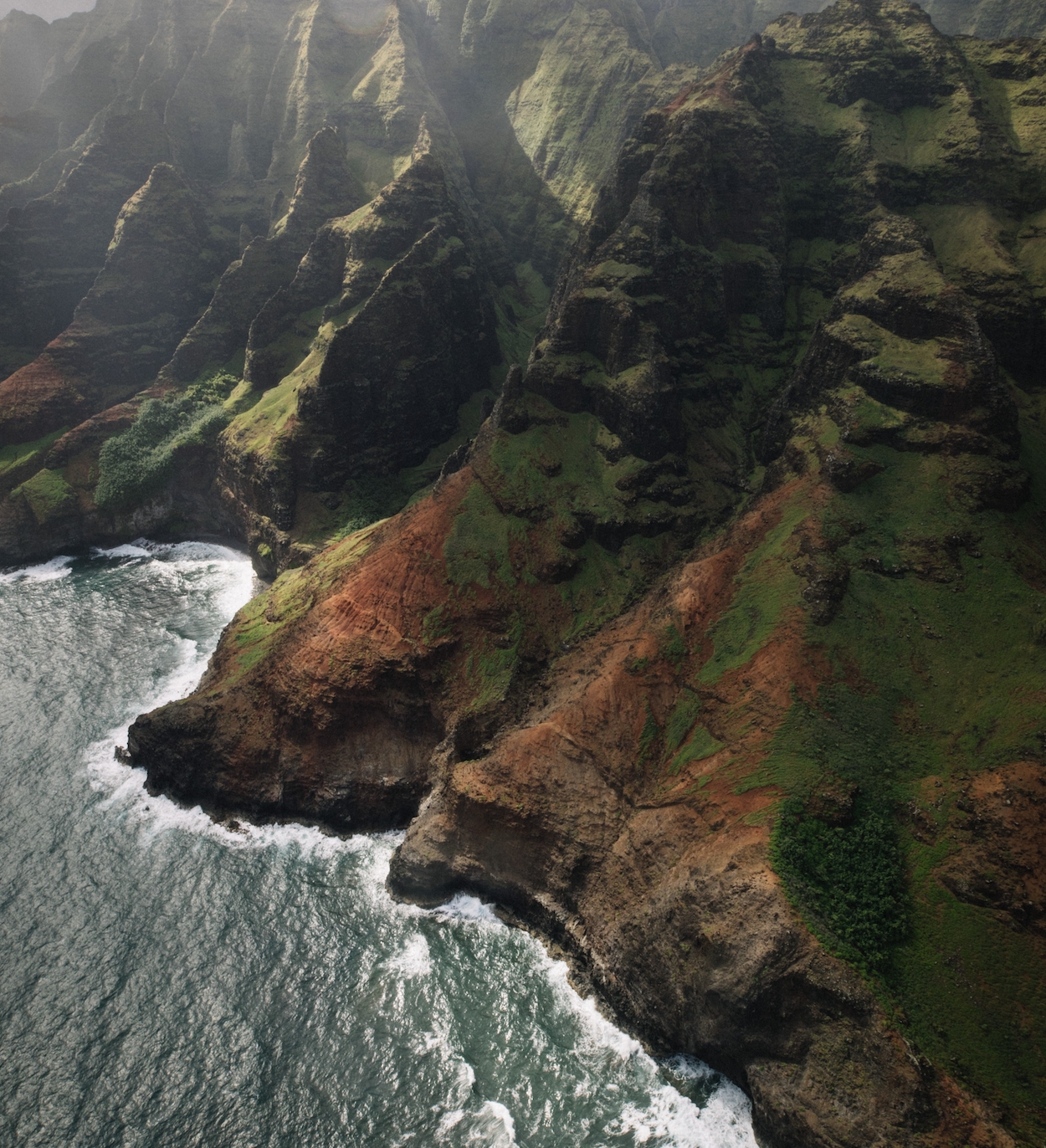
The idea that you can plant something on Kaua’i and it will metastasize in ways you never planned isn’t limited to chickens. One of the reasons Kaua’i makes such a great stand-in for Africa on film are all the albizia trees. As you drive through the flatter parts of the island you notice these giant trees with smooth, white bark that up close sort of resembles a snake swallowing prey. At the tops, their leaves grow in flat, distinct levels, like leafy apartment buildings. It’s impossible to see these trees and not to be reminded of the African plains, and there’s a good reason for that: that’s where they grew before they were introduced to the island. In dry places like the savanna they grow at a normal rate, and sturdily. In Kaua’i, frequently in the top 10 wettest places on Earth (the Kaua’i tourism industry constantly says number one or number two, but you wouldn’t believe the level of official disagreement on this point), they grow freakishly fast — up to 15 feet in the first year. And because there’s no real dry season here, they never develop the density to make them very hard or strong.
Which means that albizia trees have a tendency to topple over, and explains why they’re generally considered a menace on the island. It doesn’t take much wind for them to shed giant branches, often crushing cars and downing power lines. Even in my short time on Kaua’i, we’d often come back to the rental car and see it partly covered in boughs, and the sounds of cracking and falling branches were almost as consistent a soundtrack as singing birds. Who needs dinosaurs when even the trees are a menace?
Part and parcel with Kaua’i’s preciousness is its precarity. After visiting nearly every island in the Pacific in the early 90s, the writer Paul Theroux called Hawai’i “the most beautiful, and the most threatened, of any islands in the Pacific.” He still lives here.
The albizia flickered outside the window as we poked along the Kauaian roads, our minivan obeying Hawaii’s notoriously low speed limits. Our driver, my contact at the tourism board, who grew up in New Jersey, said she’s had to slowly learn to “drive with aloha.” In other parts of the country, we learn that “aloha” means hello and goodbye, but in Hawai’i, it’s shorthand for an entire philosophy. It seems to encompass hospitality and a live-and-let-live attitude, sure, but also a certain fatalism. It’s not just a thing people say because they’re nice, it’s at least as much a coping strategy. A sort of “Chill out, you live in paradise. Also, the road is closed because of a mudslide.”
As it relates to driving, “aloha” seems to involve allowing people to merge even when you have the right of way, trying to make everyone happy and keeping the peace even if it means a certain amount of sitting in intersections waiting for someone to make the first move. Road rage, you imagine, is much more dangerous on an island. As with most things
This conversation came on our way to a helicopter ride, probably the biggest draw of my weeklong Kaua’i itinerary. We were scheduled to fly with Island Helicopters, on the only tour allowed to actually land at “Jurassic Falls,” aka Manawaiopuna Falls, aka The Place From The Movie. I’d never flown on a helicopter before and the fine folks at the Kaua’i Visitor’s Bureau had tried to instill a healthy respect for the possibility of motion sickness, no matter how many times I assured them I possessed the stomach of an astronaut. Still, if you hear something enough times it eventually starts to sink in and I did start to wonder if I was being overconfident.
We sat in the beige waiting room as dawn broke, perusing photos of celebrity helicopter tourists on the wall — Prince Charles, Kid Rock, Kelly Clarkson, Ernest Borgnine, Randy Johnson, Pat Morita, Beyonce. There are few things I enjoy so much as a completely random assortment of famous people.
As the helicopter that was to be ours floated gently onto the field in front of a surreal green/orange Hawaiian sunrise, we signed in and stepped on the scales. We would eventually be arranged in the craft according to body weight, which is, yes, a little disconcerting. I noticed the tour operators doing the weighing never said the weight out loud, just wrote it in their book.
We met our pilot, Gary. He turned out to be exactly the kind of guy I expected to be piloting my helicopter, though I hadn’t been conscious of what that would look or sound like until it crystallized in front of me. Gary exuded a kind of patriarchal, silver fox competence, surprisingly undiminished by his small khaki shorts. I wondered how much of my subconscious conception of “competent helicopter pilot” had been imprinted by early childhood viewings of Magnum PI — Tom Selleck in bright shirts and small shorts, America’s ur-Dad.
We climbed into our assigned seats, with mine right next to Gary’s, apparently one of the benefits of being the heaviest passenger. We adjusted our headsets. Gary went through his preflight checklist in a soothing, folksy baritone, a voice with the kind of preternatural evenness common to all pilots, who seem like they could announce imminent death as calmly as they’d note the Grand Canyon out the right window.
Gary completed his pre-flight announcements over the numbing whine of the engines, dampened by the headsets, and we lifted off, the condensation on the windows first beading then hovering in motion before shooting up the glass away from the whirring rotors like little meteorites.
Flying in a helicopter is a wonderful sensation, and oddly relaxing. For all the warnings about motion sickness, I almost instantly entered a state of trance-like calm. If an airplane takeoff is like being shot out of a slingshot, a helicopter liftoff is more like being raised gently above the treetops in a giant’s palm. It did help that after Gary’s announcements stopped, a very special Gary-curated helicopter mixtape began, a mix of the Jurassic Park score and drive-time AM radio classics, the kind of sunny day rock you could imagine a drug dealer blasting while lounging on his catamaran.
Is the Jurassic Park the best movie score ever written? It definitely feels that way when you’re hovering above Kaua’i’s verdant canopy. The only thing that would occasionally puncture the reverie was that every time the main theme swelled, I kept expecting to hear the punchline verse of “Jurassic Park on a melodica,” one of the all-time great dumb internet videos, which I’ve forced old friends and new acquaintances to listen to more times than I can count.
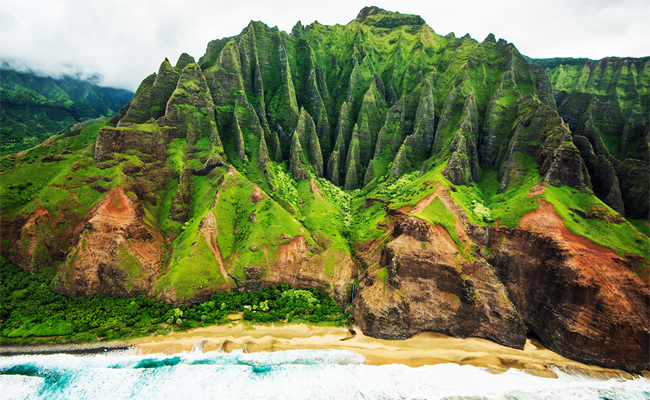
John Williams’ auditory shorthand for Spielbergian romantic wonder continued as Gary lowered us into a forested ridge with high volcanic walls on either side, creating a natural corridor. I recognized the landscape. Sam Neill’s Dr. Grant is terrified in that scene, as the helicopter bumps and judders its way down to Jurassic Park’s helipad, eventually tying his defective seatbelt into a knot when he can’t get it to buckle. The scene’s “button” is Dr. Grant smiling wryly, pleased with himself at having belatedly learning to fly with aloha.
The landing process, which in the film is bumpy and nerve-rattling, was, in reality, comprised of a gentle glide through a verdant corridor before gently touching down below a misty waterfall exploding with rainbows. (Incidentally, The University of Hawaii’s sports teams are called “The Rainbow Warriors,” though it was shortened to just “Warriors” between 2000 and 2013 when they worried rainbows were too gay).
The actual helipad the crew lands on in the movie really existed at one point, but it’s gone now, washed away in part by the same hurricane that forced Spielberg to move the production and freed all those chickens. Sue Kanoho of the Kaua’i Visitor’s Bureau, who was on the island in ’92 when the movie was shooting, says Spielberg still had his crew out shooting even as the hurricane was making landfall.
“I was hunkering down from Iniki with my family at the Westin Hotel Kaua’i Lagoons when the security guard there flagged me down. ‘Sue, Spielberg’s crew is out there filming at Kalapaki Bay. You need to tell them to get back inside — it’s not safe out there!'”
Kanoho says she relayed the message to the crew, who had apparently already gotten what they wanted. “Sure enough a clip of that hurricane footage made it into the movie,” Kanoho says. “We spent the night at the hotel riding out the storm, and when I woke up the next morning, I looked out at all the damage. Jeff Goldblum and Laura Dern were staying a few floors above us.”
All that’s left of the Jurassic Park helipad now is a cement retaining wall, which only enhances the “natural” look of the falls. Man-made structures don’t seem to last long in Kaua’i without meticulous maintenance.
Paradoxically, part of the reason these falls have been preserved for the helicopter-paying public at all is that they’re on private land — land owned by the Robinson family, the same family who own the “forbidden island” of Ni’ihau since the 1800s. As with Ni’ihau — where the religious Robinsons run a teetotalling island where off-islanders are forbidden, Hawaiian is the official language, and traditional farming and fishing are the only industries tolerated — in Manawaiopuna Falls they’ve attempted to preserve the area in its “original” state. “Original” tends to be a fraught term in Hawai’i, whose landscape has been drastically reshaped by each successive wave of colonizers — Polynesians, Europeans, Americans. A few years back, Mark Zuckerberg had made enemies on Kaua’i by trying to buy up land around his vacation home via a shell company called “Northshore Kalo LLC,” tricking some of the landowners into thinking they’d be selling their stakes to a taro farm, rather than a tech billionaire with no eyebrows. More than one Kaua’i resident brought up this story, always as an example of the kind of thing people here don’t forget. “It’s an island: you rely on each other. That person you cut off in traffic? That’s the person serving you drinks. Someone else you pissed off? He delivers your mail,” as another local put it to me.
It’s probably more accurate to say that the Robinsons’ descendants have been able to maintain their own idealized version of the place’s “natural” state. To some extent Kaua’i is a chimera, you see in it what you want to see. In any case, the family has kept the falls undeveloped and only accessible by helicopter. The helicopters, in turn, are only allowed in under specific guidelines and at limited times. For our tour, we had to wear hospital booties over our shoes to avoid bringing in any invasive species. Call it ‘pay for preservation’?
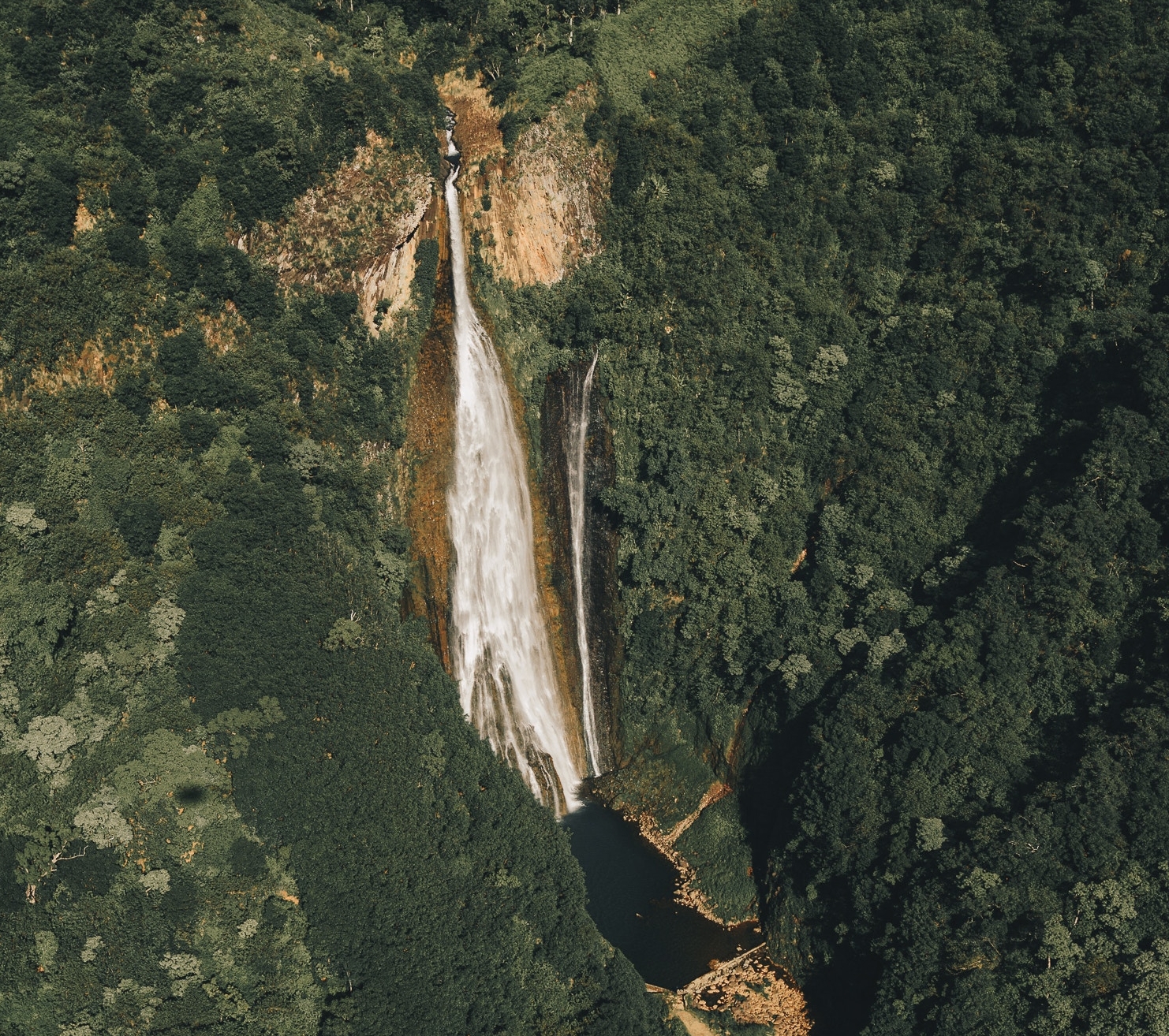
After taking our pictures on the ground, we lifted off again, tracing the 350-foot cascade of water up the columnar basalt surrounding it, hovering at the precipice practically close enough to reach out and touch the water. Incredibly, this wasn’t even the highlight of the tour.
From the falls in the Hanapepe Valley we flew overland across Waimea Canyon, a 10-mile wide, 3,000-foot deep chasm where the green of the Garden Isle briefly gives way to red, past countless more waterfalls into the caldera of Mt. Wai’ale’ale, promoted as “the wettest spot on Earth” (the superlatives are disputed, but certainly one of the wettest), a 5,000-foot extinct volcano whose microclimate created the Alaka’i wilderness, a place often called the world’s highest swamp (again, the “swamp” part is disputed), a treasure trove of endangered species and biodiversity. We flew down into the caldera and up the preposterously grand “weeping wall,” a sheer palisade of green with countless tiny waterfalls like pores on a massive face, leaking into an open-air chasm. The scale of it was otherworldly. From our hovering helicopter, we could see neither the top nor the bottom unless Gary tilted the entire craft.
From Wai’ale’ale we flew overland to the Nā Pali Coast, a rugged wilderness area on the northwest of Kaua’i that remains unspoiled, again, largely by virtue of having few roads and being mostly inaccessible. Even more so since floods in April 2018 took out the main roads. The island received almost 50 inches of rain in just 24 hours, and that wasn’t a hurricane. None of this is really on your mind when you float over it from the air, where day-to-day logistics don’t exist and everything seems easy and effortless. For the first five or 10 minutes of the ride, I was frantic, trying to capture the scale and majesty of the region on my cell phone, which is of course impossible. At a certain point I stopped taking pictures. I’d already gotten the best shot I could get. I’d gotten 50 of them. It allowed me to put the phone away and just enjoy the sensation of floating over rugged ridges and forested canopies, the closest you can get to being an eagle.
It’s impossible not to imagine what the first Polynesians to see Hawai’i must’ve thought when they first came upon the Nā Pali Coast. Bigoted European assumptions had long held that they’d achieved this feat, colonizing a massive expanse of the Pacific when pre-Columbian Europeans were still landlubbers, entirely by accident, or by dumb luck. Later research suggests that they actually had sophisticated navigational methods of their own, reading currents and waves in ways we still don’t entirely understand. Any way you slice it, discovering Hawai’i must’ve entailed spending months on the water, traveling thousands of miles across the massive unbroken blue of the Pacific, carefully rationing food, water, and boredom along the way, only to suddenly find… this. A jagged green rock shooting up out of the ocean, where fresh water goes shooting off hardened lava ridges like waterslides, surrounded by coral reefs full of fish — the wettest, greenest, most fertile, most absurdly beautiful spot on Earth.
Imagine taking that big a gamble and having it pay off this spectacularly.
And yet… this is also, clearly, a place where a single rainy day can wash away an entire settlement, where you can wake up one day to find it overrun with chickens, or giant brittle trees that shed killer branches in a light breeze. Just as soon as you found your patch of heaven it shapeshifts underfoot. Given the reality, are dinosaurs even that far-fetched? I’m convinced this partly explains some of the inherent contradictions in the stereotypical Hawaiian character — the friendliest, most laidback welcoming people on Earth who will also give you a vigorous ass kicking over a wave.
Stepping off the helicopter felt like coming down from an opiate high. It felt like trying to reintegrate into society after a week-long meditation retreat. The only thing that snapped me back into reality was a news report on the radio on the way home, describing a story of two newlyweds taking a helicopter tour on Honolulu, whose 57-year-old pilot had passed out mid-flight. At which point the chopper had nosedived into the water. Miraculously they all survived. (On the NTSB website, I only found two fatal helicopter accidents on Kaua’i, going back to 2001, and none from Island Helicopters, who’ve been operating for 38 years). I hadn’t even thought to consider the possibility of Gary’s having a heart attack or something while we were in the air.
Gary? Not Gary. Gary will live forever.
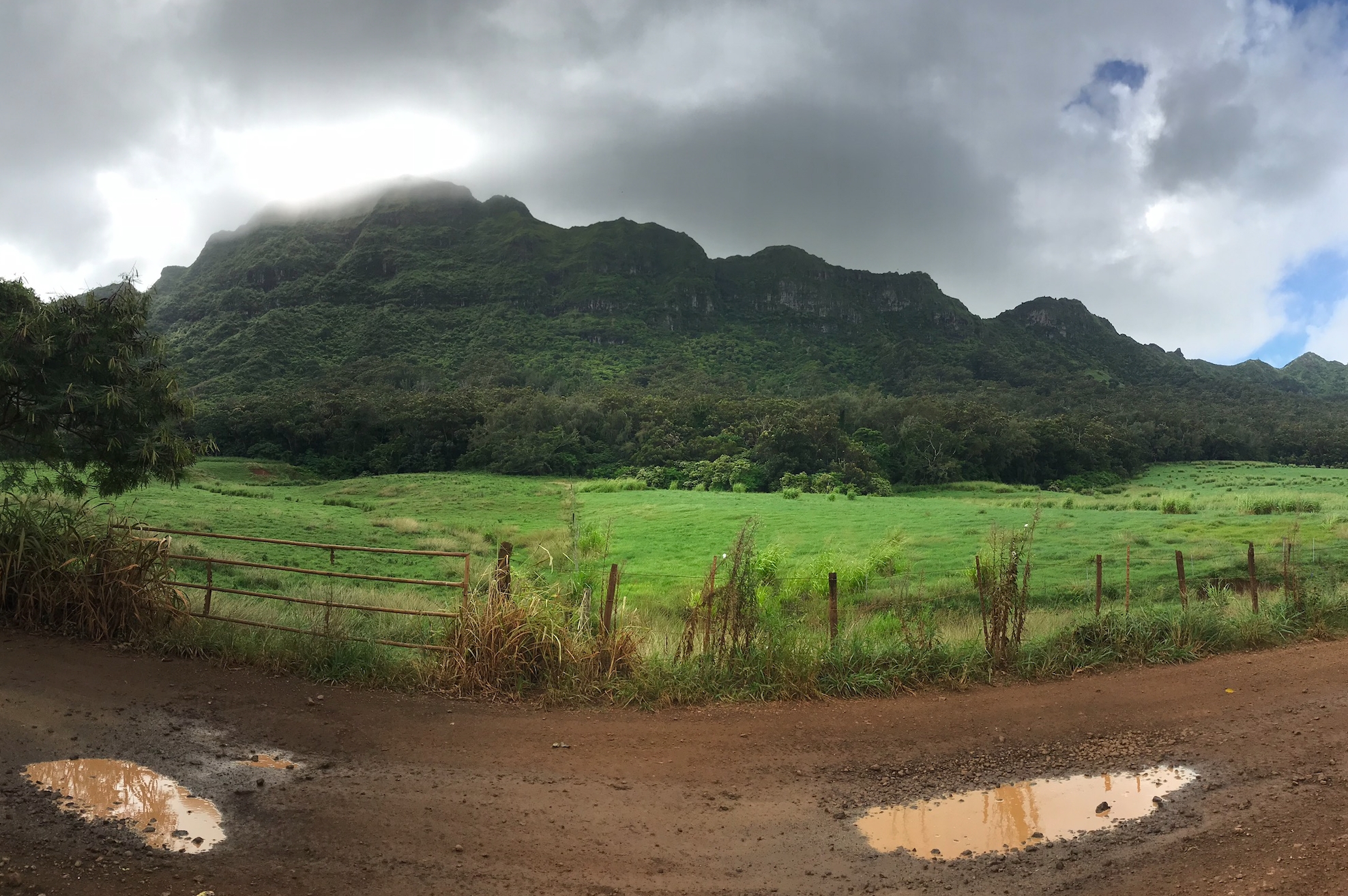
The next night at a small dinner in a roped off section of a restaurant — think trickling waterfall and a soundtrack of gentle strummy guitar music (inescapable in any public space in Hawai’i) — we meet Tobias Koehler, director of the South Shore Gardens for the National Tropical Botanical Garden. He’s tall and handsome in a backpackery granola kind of way and pronounces his name, incongruously, toe-BEE-ahs. A botanist by training, originally from the Bay Area, Tobias has been in Hawai’i 18 years and in Kaua’i for two. He has that quality common to most of the forestry majors I’ve known, where conversation drips slowly at first — presumably out of disuse — but eventually becomes a rushing torrent. He was kind of like a wind-up toy that you crank by asking about plants. After an hour or two of it he began volunteering all sorts of information on his own, like that his wife was about to have their first child, something many of his colleagues apparently hadn’t known until that night.
Tobias, who lives in a secluded area near the botanical garden, talks about having adjusted to the slower pace of life on Kaua’i, to the point that even a short trip to Maui felt like an overstimulating rat race that he couldn’t wait to get home and unplug from. For what it’s worth, I had just been in Maui, where the speed limit on a four-lane highway is 45 (yes, I got a ticket). His thoughts echoed those of Sue Kanoho, from the Visitor’s Bureau. I’d earlier overheard her telling the story of a group of Australians asking her “how many pubs” there were on Kaua’i.
“This island’s probably not for you, I told them, maybe try Oah’u or Maui.”
I quickly warmed up to Tobias, taken in by his earnestness and enthusiasm, and feeling a little bad about initially judging his affectatious name pronunciation. I spent most of the dinner chatting with him — about living in Hawai’i, about working with endangered plants, about running the botanical gardens, which gets all its funding from donations. Everyone seems to have a compelling backstory around these parts. Hawai’i, like Alaska, is still the frontier in many ways, a haven for outcasts, misfits, and dreamers. Sue was apparently a stunt woman before working with the visitor’s bureau. She talks about doubling for Jaclyn Smith from Charlie’s Angels and tells an incredible story about having to wrestle an alligator for a B-movie (its jaws were held shut with giant rubber bands). Yes, she has pictures.
Later I’ll take a kayak tour up the Wailua River (absurdly beautiful) with a guide — a compact, sinewy little guy with greying dreadlocks and plugs in his earlobes and a wonky eye. He says he came to Kaua’i to open a tattoo shop but quit when he went blind in one eye before he became a river guide. He also eventually reveals that his father played Shazam! in the old seventies TV show about Captain Marvel, and that he’s a close relative of the Gambino family, who knew John Gotti as “Uncle Johnny” growing up. He hadn’t seen the recent Gotti movie, starring John Travolta as John Gotti and directed by the guy who played E on Entourage.
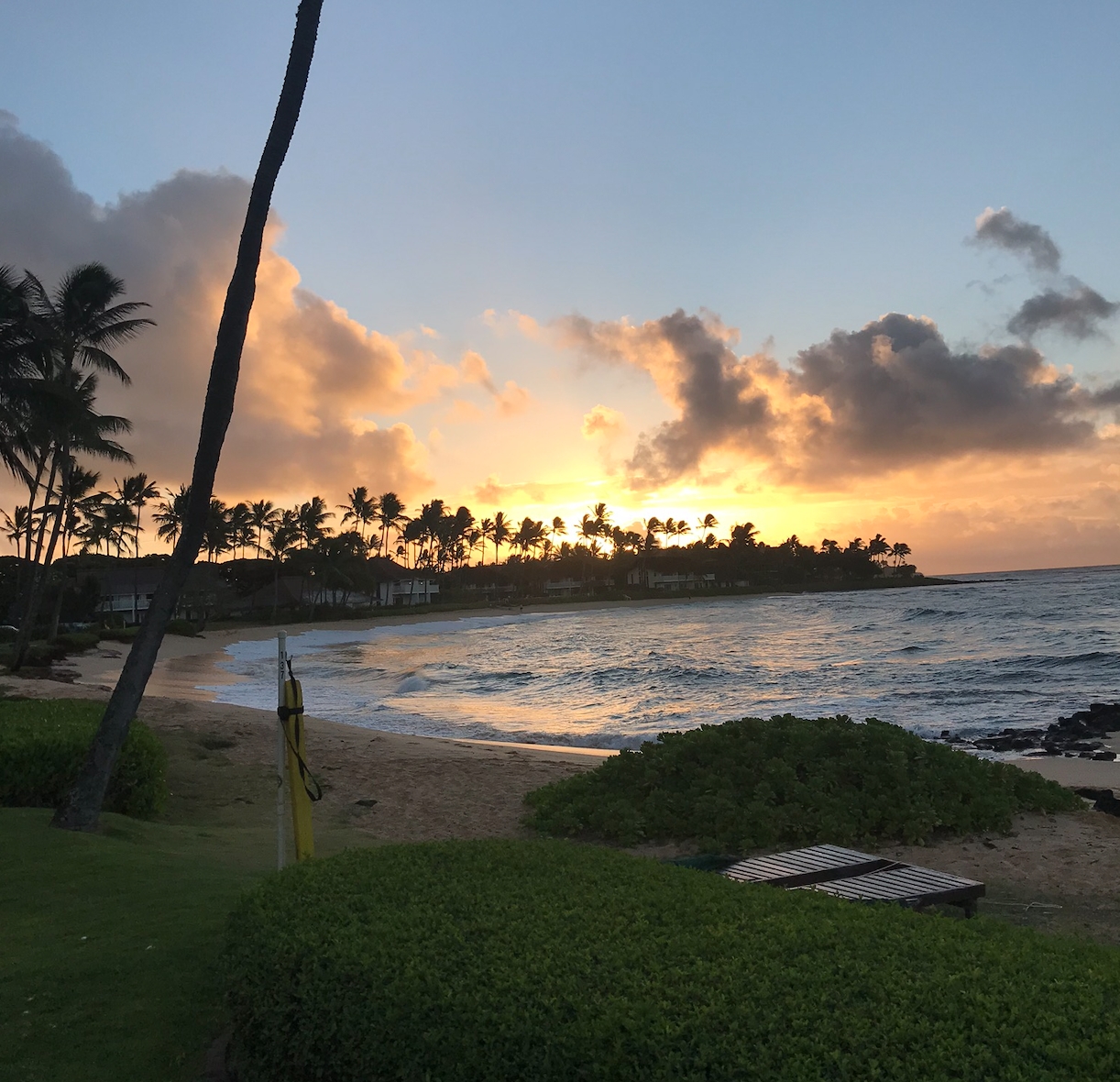
In the collective imagination, the common conception of the Pacific is that it’s a paradise, and that’s certainly not untrue. You can see that facet of it as early and often as you like, without even leaving your hotel’s lounge chair. On Kaua’i, sunrise and sunset are an event like nowhere else. The way the sun screams over the horizon and the sky changes color seemingly by the second — few places provide such a sense of the ocean’s true vastness. It feels like what it is: a tiny speck in the middle of a gigantic ocean. It’s easy to stare over the horizon and dream about what lies beyond the breakers. But the paradisiacal qualities tend to overshadow what seems to be the Pacific’s equally salient feature: its sheer peculiarity. Hawai’i seems to collect wayward humans the same way it collects invasive species. There are people who thrive here who couldn’t or wouldn’t anywhere else. I feel like I could live on the island for decades and not really know it. That’s what makes it interesting, at least as much as the scenery.
The following day, Tobias took us on a special tour of the botanical gardens. He’s a wonderfully idiosyncratic tour guide, incapable of not digressing down side streets when he’s reminded of certain stories or the histories of particular plants. The land on which the botanical garden currently sits was originally granted to the son of one of King Kamehameha I’s advisors in 1848. It was passed down through generations of Hawaiian royals until it was bought by the rich McBryde family in the late 1800s. They were then bought out in turn by a rich Chicago industrialist named Robert Allerton in 1938, who ran the gardens with John Gregg, Allerton’s presumable lover and eventual adopted son. They petitioned Congress to have it declared a national botanical garden in the sixties.
These days, the NTBG houses a breadfruit institute and works to preserve pre-European plant species. But the Allertons had run it how most people managed gardens in those days — filling it with whatever plants they thought looked nice without regard to where they had come from. Again, Jurassic Park even had its own take on this, Laura Dern’s Ellie Sattler, lecturing the park’s designers for inadvertently poisoning a triceratops because they thought a plant looked pretty. The Allertons had had the same attitude towards art, and the place retains much of their flair, shaped by the whims of esoteric art deco-era dilettantes.
A cavalier attitude towards planting introduced plant species can probably be forgiven, given the general ignorance of the time. Certainly compared to earlier missionaries, who introduced the invasive kiave, a type of mesquite now rampant on the islands, supposedly so that its nasty thorns would help the Christians dissuade the locals from the latter’s sinful practice of walking around barefoot. The story is probably apocryphal but it expresses a larger truth — imagine the hubris of a people who would travel thousands of miles from some grey, fog-choked European hellhole, probably still covered in a thin layer of coal soot and smelling of horseshit, and finding this perfect, green speck of fertile volcanic soil in the middle of a teeming blue ocean, with natives who fish for their supper and lounge under trees heavy with nutritious fruit with no need of clothes, and thinking, “Oh no this is all wrong, here let us teach you our way.”
That’s not to fatuously assign the pre-European period some mythical “innocence,” as so many have. That lifestyle surely had some “quirks” of its own — like the death penalty for women who ate bananas or pork, or for anyone who stepped on the king’s shadow. But I doubt any of their problems were caused by barefootedness. I suppose the Toms Shoes guys are their kindler, gentler descendants.
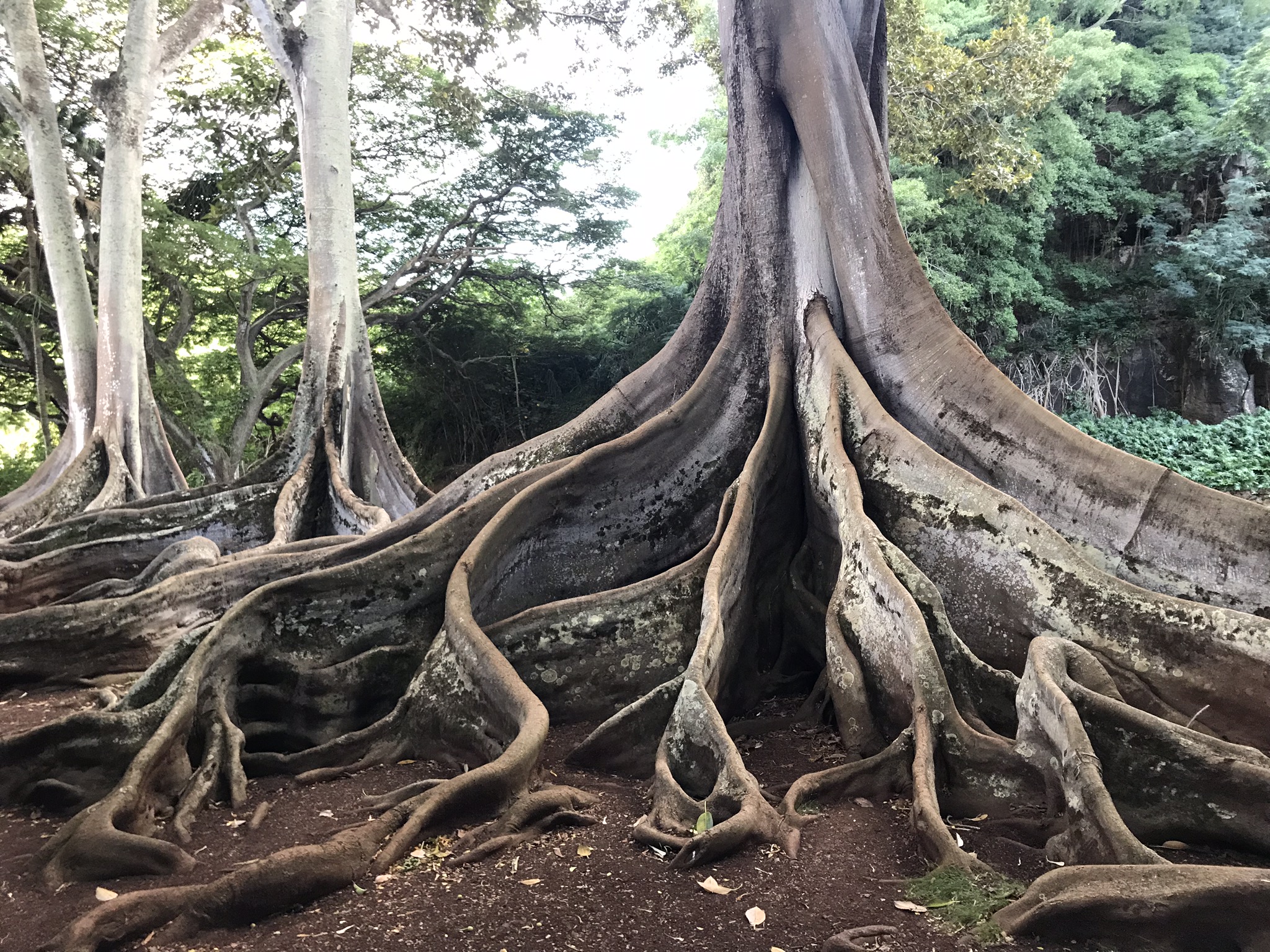
A handful of Jurassic Park scenes were shot in the garden, and many of the plants in it have that same sense of otherworldly scale, from the pea green shade of the massive, leafy monkey paw trees to the elephant ear plants underneath — a taro relative whose massive leaves give it its name and kind of look like a fern you might find after a nuclear meltdown. The centerpiece of the tour is its most memorable filming location: the Moreton Bay fig trees, whose massive, above-ground root systems became something for Jurassic Park‘s characters to clamber over as they discovered the dinosaur eggs, the scene where we learn that the allegedly all-female dinosaurs have found a way to breed (thanks to frog DNA). It’s the place where “life finds a way” proves true.
While the trees are still another foreigner (introduced from Australia) it’s easy to see how they made it into a dinosaur movie. The massive, above-ground root systems reach six to eight feet out of the ground like a nest of sharp-spined reptiles. They practically beg to be climbed on, even as a grown adult in dinner party clothes.
In his same book about traveling the Pacific, Paul Theroux wrote, “more than an ocean, the Pacific was like a universe, and a chart of it looked like a portrait of the night sky. This enormous ocean was like the whole of heaven, an inversion of earth and air, so that the Pacific seemed like outer space, an immensity of emptiness, dotted with misshaped islands that twinkled like stars, archipelagoes like star clusters, and wasn’t Polynesia a sort of galaxy?”
You get the same sense of deja vu — or is it of some underlying order of things? — while staring at a Moreton Bay Fig Tree’s root system after a helicopter ride through the Nā Pali Coast. The steep-sided roots with their high, narrow ridges, the gnarled tangles and crenelations, the way it all looks freshly chiseled, not yet sanded smooth. The root systems seem to mimic Nā Pali’s volcanic landscape — 4,000-foot pinnacled cliff faces, each peak of which the ancient Hawaiians had given names, like family members.
While the Moreton Bay Fig Trees are always grand, the roots don’t look quite the same in their native Queensland, where the soil is deeper. As with most things, their Kaua’ian iteration is unique — aspects of other places reimagined, a slight mistranslation of “elsewhere.”
As the sun began to set we walked through the giant bamboo forests at the back of the botanical garden, with bamboo stalks thicker than your femur bone, another foreign plant that seems to turn into its most idealized self-image in Kaua’i’s climate. We continued along the shore of a creek, small fish bobbing for insects in the golden hours of dusk, out to the colonial bungalow where the Allertons used to live. Palm trees lined the grass of the “front yard,” as it were, where the grass met the sand and the surf crashed against a rocky point 50 or 60 yards out, with a beach on one side and a golf course on another. (If you ever want to see a botanist grit his teeth, bring him to a golf course).
Pictures of Hawaiian royalty and wealthy landowners lined the walls of the simple house, clearly built to maximize visibility of the surrounding landscape. They stared proudly at us as we walked barefoot through a glassed-in veranda — er, lanai — for dinner, filling our plates with potato salad and barbecued chicken. A mixed plate, as it’s called in Hawai’i.
Most of the men in attendance — guests of the visitor’s bureau, husbands of hotel representatives, invitees of the botanical garden — wore crisp Aloha shirts over shorts and flip flops (“slippers,” in Hawaiian parlance) in a way that only looks formal in Hawai’i. Observing them allowed me to indulge the brief illusion that I too might look good in such a getup and not like the bassist in a ska band. How many new “looks” have had to be discarded when the tourist realizes they don’t work outside the context of his vacation?
Throughout the meal, I talked to locals who had returned home after years working abroad or on the mainland, and mainlanders and fellow Californians who had come to Hawai’i after travels in Japan and throughout the Pacific, to work in tourism in Kaua’i or to follow spouses. They now all had deep tans and a wealth of surf stories, making me simultaneously homesick and jealous.
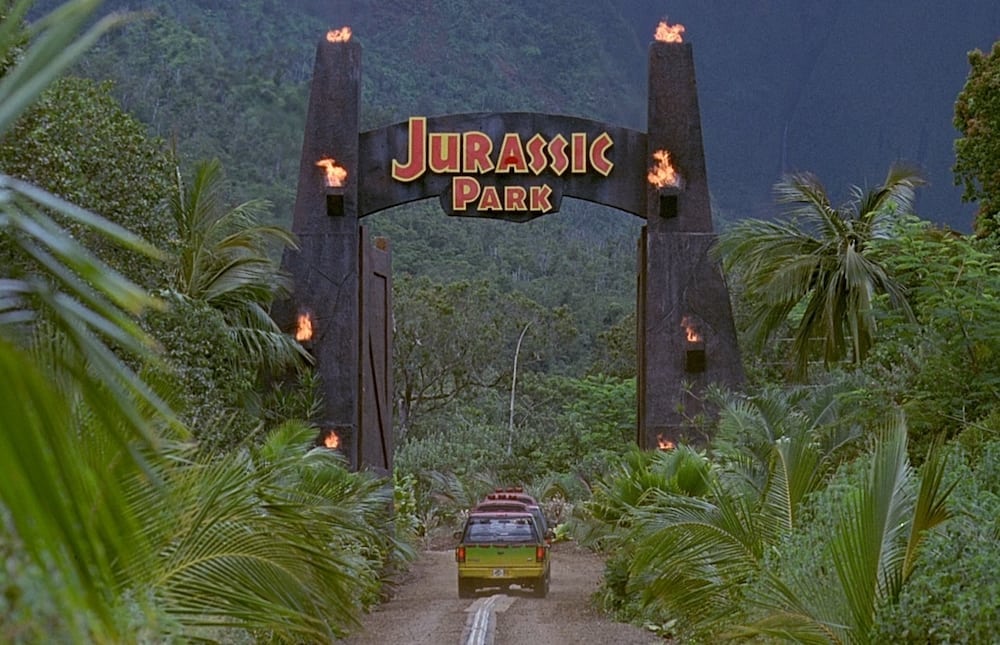
With a full head and a full stomach, I sat on a lounge chair in the grass, drinking wine and luxuriating in the atmosphere as the sky went dark and we waited for a screening of Jurassic Park to start. A full moon backlit the clouds behind the inflatable screen, peeking over the top just before the opening credits. A full moon really is magical on the island, reflecting off the water and giving everything a gauzy luminescence. Or maybe it was the wine. The visitor’s bureau staffers who planned the event kept jokingly taking credit for the timing.
“You guys see da moon? We knew it’d be perfect like that.”
Certainly, the setting helped some, but upon rewatch, Jurassic Park is Steven Spielberg’s best movie. Jaws is great, but it’s very much a product of seventies filmmaking. Raiders of the Lost Ark holds up mostly inasfar as you can remember watching it as a kid and accepting it for what it is: a pulpy comic book (and Indy’s body count is distressingly high — he starts killing people almost instantly and never seems to give it a second thought). 25 years on, Jurassic Park barely feels dated, even in the scenes where “Mr. DNA” explains the cloning process (it helps that he was supposed to be kitschy in ’93, it’d probably be worse if he’d been meant to be cutting edge).
Spielberg, more so than just about any filmmaker I can think of, is a master of tricks, of using technique to generate the desired emotion in his audience. His signature shot has been dubbed the “Spielberg Face,” a slow push in on a character’s awe-struck face as the gravity of their situation slowly dawns on them. Fitting then that Jurassic Park is the most Spielberg-Face-dense of any Spielberg movie. Jurassic Park is wall-to-wall Spielberg faces, and it’s the Spielberg film where the characters’ awe the feels most earned. It’s the film where all of Spielberg’s bullshit works. The ripples in the water cup, the dilating dino pupil — so many tricks!
A lot of that is due to the realistic-looking dinosaurs, sure, (and the 1995 animatronics still for the most part look better than their mostly CGI counterparts of present day), but at least partial credit has to go to the setting. I spent my entire time on Kaua’i running around like John Hammond, treasuring each new anomaly like it was a dinosaur egg. Look at the leaves, look at the rocks, look at the chickens! Look at the way the red moon sinks into the horizon just before dawn!
Kaua’i has a way of turning everyone into a romantic. Leaving it is kind of like a breakup. It was raining (but still warm) on the day I had to return home. I got a bowl of saimin near the airport — a sort of Hawaiian version of ramen with Filipino and Chinese influences — and my full belly combined with the grey skies amplified the melancholy. I felt satisfied and contented, but somehow sad, wistful for a moment in time even as I was experiencing it. Maybe it’s sadder to leave a place so mutable, knowing it won’t be the same by the time you return.
Vince Mancini is on Twitter. You can check out his archive of reviews here. Uproxx was hosted for this story by the Kaua’i Tourism Board. You can learn more about the Uproxx Press Trip policy here.
†At least, mostly filmed. the production had to be moved to Oahu after Hurricane Iniki — the most powerful hurricane to strike Hawaii in recorded history — struck Kaua’i in September 1992. The scene where the kids and Dr. Grant are watching a gallimimus stampede, for example (“Um, they’re flocking this way”), starts in Kaua’i, but once they jump over the log they’re on Kualoa Ranch in O’ahu.
